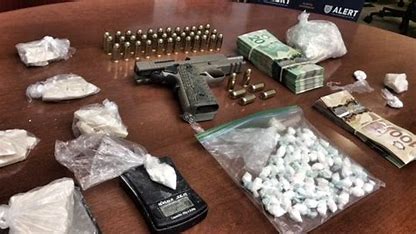With synthetic drugs flooding both the domestic and international markets, for the Sikh community in Canada, these incidents underscore a troubling pattern of gang recruitment targeting a section of their youth,
NEW DELHI: The bust of a Canadian “super-lab” used for mass drug production, along with the arrest of suspect Gaganpreet Randhawa, has underscored the vast reach of drug networks in Canada and the extensive criminal infrastructure supporting drug manufacturing and distribution.
The 25 October operation, which targeted a sprawling drug lab in Falkland, British Columbia, led to the seizure of unprecedented quantities of fentanyl, methamphetamine, and other illegal drugs, along with an arsenal of loaded firearms and explosives. Officials from the Royal Canadian Mounted Police (RCMP) described the lab as the most sophisticated ever seen in the country, estimating the dismantling costs alone at over $1 million. They believe organized crime groups with international ties orchestrated the operation to supply Canada and lucrative overseas markets.
While Randhawa, a person of Indian origin, will be presented before the court on 14 November, it is suspected that he is just a foot soldier for the drug cartel that was running this lab which was located east of Kamloops in the rural community of Falkland.
Investigators seized 54 kilograms of fentanyl, 390 kilograms of methamphetamine, 35 kilograms of cocaine, 15 kilograms of MDMA, and 89 firearms, including assault rifles, submachine guns, and silencers, highlighting the criminal syndicate’s readiness for armed conflict. The staggering quantities of drugs are estimated to be worth nearly $500 million, with methamphetamine likely destined for markets in Australia and New Zealand, where demand and street prices remain high.
The seized drugs are just one example of how Canadian gangs profit immensely from synthetic drug production, trafficking not only in Canada but also to high-demand international markets, including Australia, where meth can fetch prices up to CAD 185,000 per kilogram. Canadian ports, notably Vancouver, have become key transit points for smuggling operations, with large quantities of meth and precursor chemicals frequently discovered en route to Australia and New Zealand.
This case has brought renewed scrutiny to Canada’s interconnected networks of drug trafficking involving persons of Indian origin, organized crime, and violent gang rivalries.
Randhawa is allegedly linked to the Wolfpack, a powerful Canadian gang alliance. The Wolfpack, formed in British Columbia and comprising factions of different criminal gangs—Hells Angels, Independent Soldiers, and Red Scorpions—has expanded into international drug trafficking, particularly through partnerships with Mexican cartels, Asian triads, and Middle Eastern groups.
The Brothers Keepers, an Indo-Canadian gang with rivalries against Wolfpack members, has been implicated in numerous high-profile shootings.
The RCMP has linked both Wolfpack and Brothers Keepers to drug smuggling rings.
Recent years have seen escalating violence among these groups, with incidents like the June 2023 daylight assassination of Hardeep Singh Nijjar, a Khalistani supporter, intensifying the focus on gang-related violence within a section of the Sikh community in Canada. India had named Nijjar as a wanted figure for his links to the Khalistan movement, an assertion Nijjar’s supporters vehemently denied.
His killing, which remains unsolved, has led to strong speculation that criminal elements might have been involved, given Nijjar’s alleged involvement in the fight for supremacy in the area which also is related to the lucrative drug business.
The recent Falkland bust, along with the murders of Sikh gang members and leaders, has raised concerns over the role of organized crime within specific communities and its impact on broader Canadian society.
With synthetic drugs from labs like Falkland flooding both the domestic and international markets, for the Sikh community in Canada, these incidents underscore a troubling pattern of gang recruitment targeting a section of Sikh youth, as crime networks seek to exploit vulnerable individuals for their operations with allegations
In August 2022, on the list of 11 most wanted gangsters that was released by Canadian police, nine were of Indian origin, indicating how deeply a section of the said community was affected by gang related crimes.
Khalistani-linked narco-terrorism networks first emerged in the 1990s, as highlighted by the high-profile murders of Jimmy and Ron Dosanjh—two drug dealers affiliated with the International Sikh Youth Federation (ISYF)—in Vancouver’s gang wars. Jimmy Dosanjh was killed in February 1994, and Ron was killed in April 1994 as per court records.
The arrival of ex-members of Khalistan movement into Canada opened new channels for cross-continental drug trafficking, enabling collaboration with criminal networks in Punjab.
The arrest of former Punjab wrestling champion and police officer Jagdish Singh Bhola exposed the vast scale of this illicit enterprise, revealing a billion-dollar drug supply network funnelling heroin and methamphetamines from India to North America and Europe through Canadian contacts. Bhola’s capture brought to fore the well-organized web of transnational crime linking Canadian-based criminals with Punjab’s drug trade.
In July 2024, a special Prevention of Money Laundering Act court in Mohali convicted and sentenced Bhola to up to 10 years of imprisonment.

